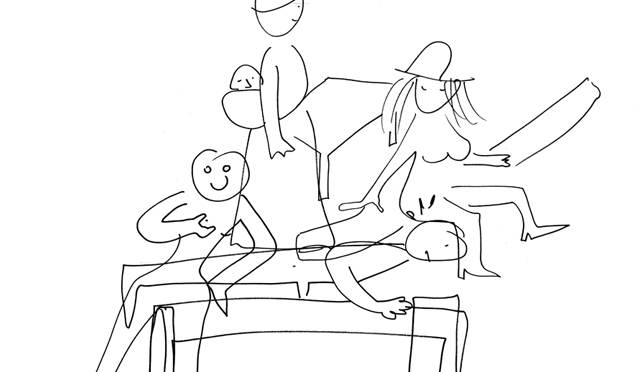Search
To search for an exact match, type the word or phrase you want in quotation marks.
A*DESK has been offering since 2002 contents about criticism and contemporary art. A*DESK has become consolidated thanks to all those who have believed in the project, all those who have followed us, debating, participating and collaborating. Many people have collaborated with A*DESK, and continue to do so. Their efforts, knowledge and belief in the project are what make it grow internationally. At A*DESK we have also generated work for over one hundred professionals in culture, from small collaborations with reviews and classes, to more prolonged and intense collaborations.
At A*DESK we believe in the need for free and universal access to culture and knowledge. We want to carry on being independent, remaining open to more ideas and opinions. If you believe in A*DESK, we need your backing to be able to continue. You can now participate in the project by supporting it. You can choose how much you want to contribute to the project.
You can decide how much you want to bring to the project.

We recover today the editorial directed by Virginia Lázaro Villa in May 2020 (yes, in the middle of confinement): Laughing Out Loud.
Virginia spoke of virality (of viruses and social networks), of isolation and connection, of how “the social gives way to the viral, and the memetic acquires an evangelical character in which humor plays a leading role”. She was accompanied on this journey by Sabina Urraca on the laughter of LOL that does not need to exist; Anónimo García explored the emancipatory force of LOL; Daniël de Zeeuw wrote about subversion, satire, and parody and, finally, Alicia Adarve claimed the value of memes as a testimony of their time.
It is precisely on this point that we are going to stop, because for some time now, the Biblioteca Nacional de España has been preserving not only books and magazines but also what happens on the Internet, and it is in this block where memes have a place. José Carlos Cerdán, head of the BNE’s Online Publications Depository Service, explained this to the publication Ethic: “We store memes, but they are part of everything we conserve. The best way to understand it is to think about the humorous cartoons in newspapers from 50 or 100 years ago. They are also in the BNE because they make it into the pages of the preserved newspapers. That’s the key, they are part of what we keep”. They are, in short, time capsules that make up the collective cultural heritage.
Through associative concepts and games of literality-non-literality, these musical suggestions distill, complement, or enhance the theme developed in the editorial.
LAUGHINGOUTLOUD
Within the practice of diving between genres, throughout the history of music, finding new frameworks of enjoyment or study is always something to be grateful for. Sifting through, pulling the skein, linking, and letting oneself be traversed by all that information is a habit of many music lovers and has become a basic procedure for this kind of collaboration.
When I started thinking about the soundscape to illustrate Virginia Lázaro’s article, I dived into the music associated with viral videos, which is a genre in itself, full of songs of very different kinds, styles, and intentions that suddenly invade your feed, making those specific seconds stick in your brain, because they are certainly always short fragments. Leaving aside the field, worthy of study at all levels, of those songs associated with the so-called “trends”, I focus on something that we could call a sub-genre of viral music, those songs (or fragments) that are recurrent in a certain type of video. Listening to a list of “memetised” songs, one entitled “end credits meme” catches my attention. I recognize it from having heard it, years ago, as the music accompanying a credit sequence, on countless occasions, already immortalized as a reiterative meme at the end of short clips of people in awkward, peripatetic situations. Overall, the aim is to ironize, if not ridicule in a more pernicious way, other people’s blunders. This editing gag has been used since 2015, it has an original format and perhaps a more specific target, due to its origin and referential content, but it also works without this previous knowledge, due to the music itself, I would say.
This is the story of the song. Composed by Luciano Michelini for the film “La bellissima estate”, in 1974, where it appears as a leitmotif accompanying a humorous character. After being included some time later in a large catalog of “bookshop music”, it reached Larry David’s ears through a bank advertisement. The comedian, writer, actor, and television producer is the creator and star of the hit series “Curb Your Enthusiasm”, which began airing on HBO in 2000 and continues, with some hiatuses, to this day.
Because of its circus-like character, the typical musicality of the BSOs of the time, such as those of Nino Rota or Ennio Morricone, with their tuba and mandolins of whimsical melody, and other instruments such as the characteristic plunger flute, with implicit humorous connotations (forged through many audiovisual and show business artifacts), this is a piece that “sounds like humor” in itself, although it is true, in my opinion, that it would not represent so much the drift of the cruellest trolling or mockery typical of the networks, but rather a somewhat whiter and finer humor.
Luciano Michelini
Track: Frolic

Josephine Soundscapes is Jose Salas, art director, graphic designer and audiovisual creator. His career is linked, for the most part, to the independent cultural network of Madrid, in the fields of visual arts, audiovisual and music, both from his personal or collective projects such as Machines Désirantes Buró, Fast Gallery, Silly Europeans, Alkomerz (Berlin), Paraíso Madrid or Sonda Dispersa (M21 Radio), as well as for institutions such as CA2M, La Casa Encendida or Matadero Madrid. Under his alias Josephine Soundscape he works as a DJ, radio host, promoter and programmer, in clubs, parties and festivals, as well as in radio projects and collaborations with the performing arts environment, partly from his independent promoter a_mal_gam_a, or in other projects such as CALMA, Radio Relativa or in the Festival BetaPública de Teatros de Canal.

A*DESK is a critical platform focused on publishing, training, experimentation, communication and dissemination in relation to contemporary culture and art, which is defined by transversality. The starting point is contemporary art, because that is where we come from and this awareness allows us to go much further, to incorporate other disciplines and forms of thought in order debate issues that are relevant and urgent for understanding our present.
"A desk is a dangerous place from which to watch the world" (John Le Carré)